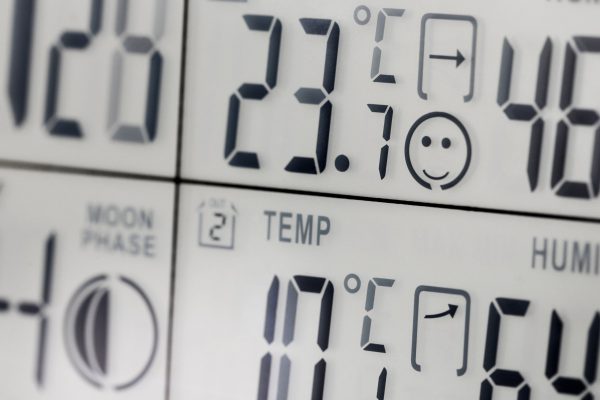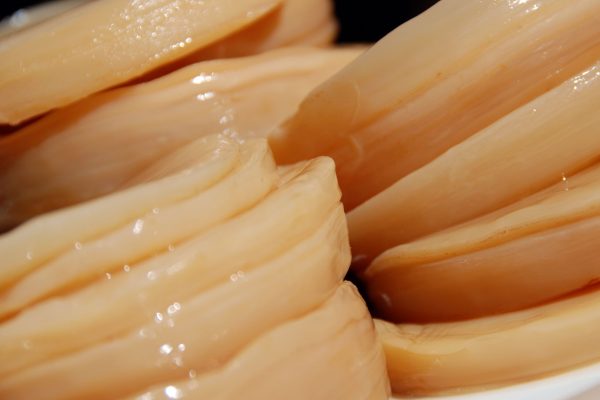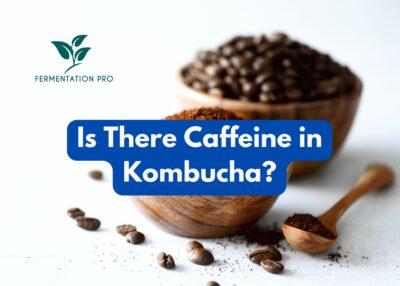Have you ever noticed how your favorite Kombucha’s taste and fermentation time vary when brewed at different temperatures? Like other fermented beverages, temperature serves as a crucial factor for brewing Kombucha. The Symbiotic Culture of Bacteria and Yeast or simply called the SCOBY stays active at a specific temperature range. Depending on the temperature, the SCOBY can ferment slower or faster and produce a strong or weak-tasting Kombucha drink. So, what is the optimal temperature for brewing Kombucha?
Kombucha is a health-boosting beverage fermented between 60℉ to 85℉. However, Kombucha brewed on the warmer end of this temperature range, between 75℉ to 80℉, has the most delectable balance of sweetness and tartness.
Table of Contents
How Does Temperature Affect Kombucha?
Kombucha is a healthy beverage fermented with the help of the SCOBY or Symbiotic Culture of Bacteria and Yeast. Like other microbes or cultures, temperature can have a direct effect on the growth and metabolism of SCOBY. Essentially, the higher the temperature, the more active the yeast and the bacteria in the SCOBY become, and the faster they can convert sweet tea to Kombucha. In contrast, when the temperature is low, they tend to go dormant and ferment Kombucha at a slower rate. If the temperature becomes too cold, the SCOBY can go inactive and stop fermentation completely.
The microorganism’s growth and activity do not just affect the fermentation time but also the taste of Kombucha. A healthy and active SCOBY ferments Kombucha that has a strong and tart savor. On the other hand, a SCOBY that is lesser active ferments Kombucha with a milder and sweeter taste.

How To Maintain an Ideal Temperature in Brewing Kombucha?
- Consider the location of your fermentation station
Various locations in the house can have different temperatures. If you live in a place with a warmer climate, place the Kombucha vessel in a cool location in your house such as a dark cupboard or the basement.
If the temperature in your house is cool such as in winter, store your Kombucha brewing vessel in a warm spot. The most common warm spots in the house during cold seasons are above the fridge, near the heater/radiator, and in the laundry room.
- Check the temperature regularly
Checking the temperature regularly is always a good measure to keep the temperature within the ideal brewing temperature especially when you are fermenting during the cold seasons. To measure the fermentation temperature, you can use an adhesive thermometer or thermostat. These tools give you an accurate reading on the temperature so you can warm up your Kombucha whenever the temperature drops.
- Use heating devices
Heating devices like a heating mat and heat tray are great for keeping your Kombucha warm when you are fermenting. They provide regular heat for the Kombucha so you can feel at ease leaving your Kombucha alone. If you don’t have heating devices available, you may also use string lights or Christmas lights. Simply wrap it all around the vessel to distribute the heat equally through the Kombucha.
What Temp Is Too Hot For SCOBY?
A SCOBY is naturally resilient however exposing or storing it at a hot temperature can definitely damage its health or worse, kill it. SCOBY is at its best health when kept at a temperature between 60℉ to 85℉. Storing it above this temperature can affect the SCOBY’s health. If the SCOBY gets exposed to a temperature above 100℉, chances are its yeast and bacteria will die.
According to happyherablist.com, temperatures above 95℉ can stop most fermentation processes. When the temperature reaches 105℉ most yeasts will begin to die. At 140℉, the yeast will die in just a few minutes.
What Temperature Kills Bacteria in Kombucha?
Kombucha contains a high amount of bacteria called probiotics bacillus coagulants. These bacteria are known for their capability for fermentation. Exposing these live probiotic cultures to temperatures over 115℉ is enough to kill them.
While Kombucha is known to contain good bacteria, Kombucha may also contain bad bacteria that can cause an upset stomach and allergic reactions. These bacteria are often caused by fermenting Kombucha under unclean conditions. If you worry about these bacteria, you may opt to heat or pasteurize the Kombucha to eliminate the colonies of potentially harmful bacteria in the beverage. However, doing so will also eliminate its gut-friendly bacteria or probiotics.
Killing the bacteria in Kombucha is considered unnecessary if it is brewed in a clean and well-maintained location. Nevertheless, if you really want to get rid of the bacteria in Kombucha for safer consumption, here is how you can do it at home.
How to Kill the Bacteria in Kombucha
While heating gets rid of the probiotics in Kombucha, it will also kill the bacteria that may cause adverse side effects to the body.
Killing the bacteria in Kombucha is done through the process of pasteurization. Pasteurization is the process of heating a substance to a specific temperature to kill all the bacteria in it. According to a recommendation from the PA Department of Agriculture, the simplest way to pasteurize Kombucha is to heat it to 180℉ and bottle it immediately. Next, invert the bottles after 30 seconds. Then, keep the bottles in their inverted positions for another 30 seconds. Finally, allow the bottles to cool and store the Kombucha accordingly.
Pasteurized Kombucha is safe to drink for most kids and adults. It also has a longer shelf life and doesn’t require refrigeration.
Is 68℉ Too Cold for Kombucha?
The short answer is no. However, you should expect that the Kombucha will take longer to ferment at this temperature. 68℉ keeps the bacteria and yeast in the Kombucha weak and slow. This slows down their fermentation activity and lengthens Kombucha’s fermentation time. Fermenting Kombucha at 68℉ can take 3 weeks and more depending on the fermentation progress and preferred taste.
The long fermentation time also means that the Kombucha takes longer to get acidic. Without acidity, Kombucha becomes more prone to mold and contamination. If you see any visible signs of molds in your Kombucha, throw the entire batch away and start again. Drinking Kombucha contaminated with molds may cause adverse effects to the body like upset stomach, infections, and more.
To protect your brew from molds, make sure to store your Kombucha in a clean dry place and away from possible contaminants like trash and plants. In addition, keep the temperature of your fermentation station within the ideal brewing temperature range. If possible, you may consider investing in Kombucha heating equipment to speed up the fermentation and increase the acidity level of Kombucha faster.
In addition to slower fermentation and a higher risk of molds, Kombucha brewed at this temperature leads to slower SCOBY growth. A small SCOBY ferments Kombucha at a slower rate and gives it a milder and sweeter taste.
Should I Stir My Kombucha While It’s Fermenting?
Stirring your Kombucha while it is fermenting will not necessarily affect your brew negatively, however, this can increase the risk of contamination in your brew. Hence, we suggest leaving your brew alone to ferment.
The best time to stir your Kombucha is before bottling. Yeast settles down at the bottom of the brewing vessel during the first fermentation. If you don’t stir your Kombucha liquid before bottling, the yeast won’t be evenly distributed throughout the liquid and your bottled Kombuchas will have inconsistent tastes.
If you are doing a continuous brew, you may stir your Kombucha every time you transfer the Kombucha liquid to your cup or bottle to remove the yeast that may block the brewing jar’s spigot.

How Many Times Can I Reuse SCOBY?
SCOBY is resilient and reusable however, like any other living being, SCOBYs are not everlasting. Essentially, you can reuse a healthy SCOBY up to four times before it gets too old and weak. After four uses, you will have to discard the SCOBY and use a new one. Some SCOBY can last longer than this however, they may produce milder-tasting Kombucha and take longer to ferment.
Don’t worry about discarding or losing a SCOBY because every time you ferment, the original SCOBY or mother SCOBY produces a new pellicle of bacteria and yeast, also called the baby SCOBY. Baby SCOBYs often mature in just 7 days to 2 weeks depending on the culture activity and metabolism.
What Happens If You Ferment Kombucha for Too Long?

If you ferment Kombucha for too long, it will continue fermenting and will eventually turn to Kombucha vinegar. Kombucha vinegar is the result of over-fermented Kombucha. It has a very acidic taste that is too sour for consumption, hence instead of drinking, Kombucha vinegar is often used for different purposes. These include:
- Strong starter tea for the next Kombucha batch
- Salad dressing
- Natural hair rinse
- Facial toner or makeup remover
- Natural multipurpose cleaning spray
To prevent Kombucha from over-fermenting, taste your Kombucha brew regularly. During the first fermentation, you can start tasting your Kombucha after 4 to 5 days of fermentation. In the second fermentation, start tasting your Kombucha after 3 days. Continue tasting your Kombucha until you reach your preferred balance of tart and sweet.








